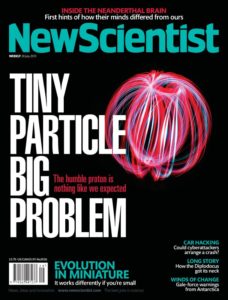Published in New Scientist, 22 Jul 2013
Curious goings-on at the heart of the atom may be pointing to a new force of nature
 ONE quadrillionth of an inch. If you lost that off your waistline, you wouldn’t expect a fuss. Then again, you are not a proton.
ONE quadrillionth of an inch. If you lost that off your waistline, you wouldn’t expect a fuss. Then again, you are not a proton.
Until recently, it was unthinkable to question the size of the proton. Its radius is so well known that it appears on lists of nature’s fundamental constants, alongside the speed of light and the charge of an electron. So when Randolf Pohl and his colleagues set out to make the most accurate measurement of the proton yet, they expected to just put a few more decimal places on the end of the official value. Instead this group of more than 30 researchers has shaken the world of atomic physics. Their new measurement wasn’t just more accurate, it was decidedly lower. The proton had apparently been on a diet.
Freak results do turn up from time to time in physics. Witness the furore in 2011 over the neutrinos that appeared to travel faster than light and whose unbelievable powers were traced months later to a dodgy cable connection. Yet the proton puzzle first came to light in 2009, and several experiments later we are running out of ways to explain how the particle can have seemingly shrunk. No experimental flaws have been found. The theory has been checked and rechecked. Physicists are now facing the possibility that a new phenomenon is at work. Has a big problem with a tiny particle revealed a brand new force of nature?
“As Sherlock Holmes would put it, ‘Once you eliminate the impossible, whatever remains, no matter how improbable, must be the truth’,” says Itay Yavin, a particle physicist at McMaster University in Hamilton, Canada. “That is new physics.” […]
The rest of this article is available here.